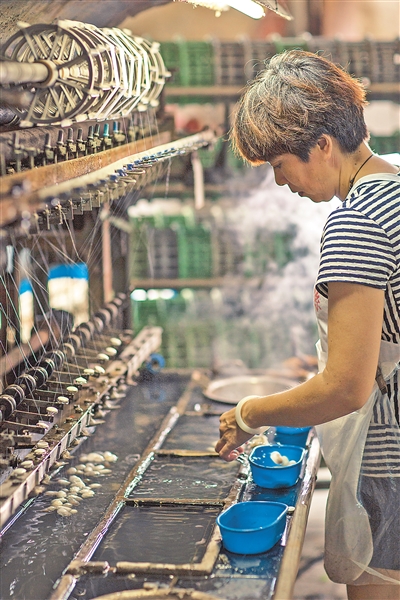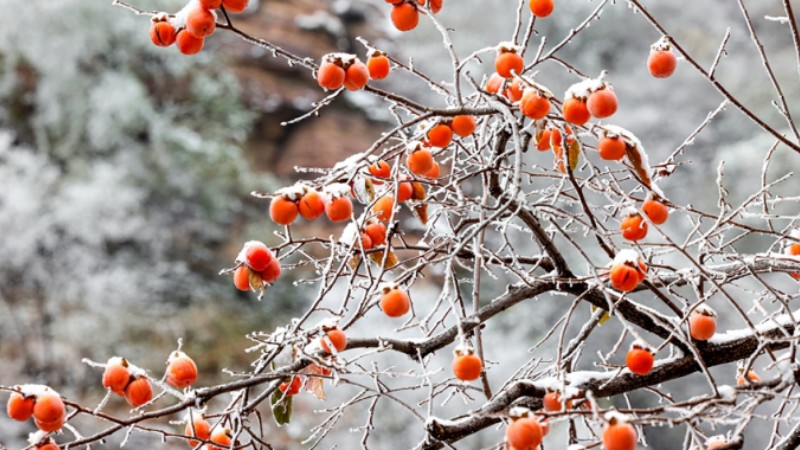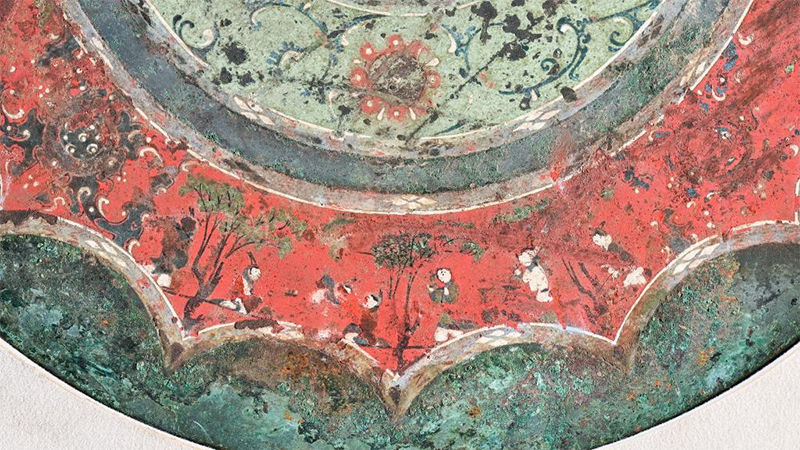Suzhou's Wujiang district cultivates thriving silk industry
Wujiang district in Suzhou city, east China's Jiangsu Province is a well-known hub for silk production. With a rich history in silk culture, Wujiang has witnessed the evolution of the silk industry over thousands of years. Today, the industry has experienced a significant transformation.
At 5 a.m., 69-year-old Zhou Yinmei, a mulberry farmer from Sanshan village in Zhenze township, Wujiang district, went out to check on her mulberry trees.

A worker operates machinery to reel silk at a factory in Zhenze township, Wujiang district, Suzhou city, east China's Jiangsu Province. (Photo courtesy of the Office of Party and Government Affairs of Zhenze township)
In Zhou Yinmei's youth, silkworms were raised in almost every household in the village, and mulberry fields could be found everywhere. However, with the advent of industrialization, traditional sericulture gradually declined. Nowadays, only a few elderly individuals like Zhou Yinmei still stick to this age-old practice.
Wujiang has been actively promoting the high-quality development of the silk industry. This has been achieved through various means such as policy guarantees, resource aggregation, and brand building.
"For us, silk holds not only nostalgic memories but also deep emotional connections," said Zhu Wenchao, general manager of Suzhou Jili Silk Co., Ltd., whose products are exported to Japan, Canada, and other countries, and enjoy great popularity.

Photo shows wood weaving machines in a Song brocade culture park in Wujiang district, Suzhou city, east China's Jiangsu Province. (Photo courtesy of Wujiang Dingsheng Silk Co., Ltd.)
More and more practitioners like Zhu have joined the industry. Today, there are over 200 silk companies in Zhenze township, and they can sell over 3 million silk quilts in a year.
Kaixiangong village in Wujiang's Qidu township is famous for mulberry and silkworm cultivation.
Liu Ying, a 61-year-old local entrepreneur, started working in a state-owned silk reeling factory when she was young. In 2003, Liu established her own silk factory. Today, her business boasts an impressive annual output value of nearly 100 million yuan ($13.8 million).
To preserve the silkworm and mulberry culture, the local government and Liu jointly built an ecological agricultural landscape project in Kaixiangong village. Covering 500 mu (33.33 hectares) of land, the project aims to recreate the scenes of mulberry cultivation from the past.

Workers stretch silk quilts at a factory in Zhenze township, Wujiang district, Suzhou city, east China's Jiangsu Province. (Photo courtesy of the Office of Party and Government Affairs of Zhenze town)
Zhou Qin'e is a 68-year-old retired teacher and a sericulture expert. According to Zhou Qin'e, in her youth, a silk quilt was considered the most valuable dowry for girls, and it took her family several years to save enough silkworm cocoons to make one silk quilt for her.
In 2017, Zhou Qin'e joined a silkworm and mulberry culture park as a promoter of silkworm and mulberry culture. Every morning, she tends to the silkworms, ensuring the mulberry leaves are plentiful, monitoring temperature and humidity, and observing the growth of the silkworms. After completing these tasks, Zhou Qin'e turns into a lecturer, teaching sericulture to children on study tours.
In recent years, Zhenze township has witnessed the emergence of several new landmarks in the silk industry. Additionally, a variety of activities centering around silkworm and mulberry culture have been enthusiastically carried out in the local community.
Shengze township in Wujiang district is also famous for silk production.

Photo shows an aerial view of a silkworm and mulberry culture park in Wujiang district, Suzhou city, east China's Jiangsu Province. (Photo courtesy of the silkworm and mulberry culture park)
Jiangsu Huajia Silk Co., Ltd., originally a silk reeling factory in Shengze, has evolved into one of China's leading silk enterprises with a history of over 50 years. In 2022, the company accounted for nearly 60 percent of the country's high-end silk export share.
Song brocade is renowned for its intricate patterns, delicate compositions, and elegant colors. However, due to high production costs, it once faced the risk of disappearing, according to Wu Jianhua, chairman of Wujiang Dingsheng Silk Co., Ltd.
In 2009, Wu took over a struggling silk factory and started revitalizing Song brocade.
After years of dedicated efforts, Wu and his team have achieved a balance between manual craftsmanship and production through the use of machines. They have successfully developed an electronic jacquard loom that aligns with the traditional weaving techniques of Song brocade while meeting various technical requirements. This advancement has significantly enhanced production efficiency.
"Our goal is not only to revive the Song brocade but also to promote and establish its global recognition," Wu said.
Wujiang Dingsheng Silk Co., Ltd. introduces nearly 100 new products every quarter. The company combines the Song brocade with yarns like cashmere and wool, pushing the boundaries of creativity.
In 2022, Wujiang's silk textile industry achieved an impressive output value of 107 billion yuan.
Photos
Related Stories
- Trending in China | Zhuang Brocade: a treasure of Chinese culture
- The ink that takes five years to make: Longquan lotus silk paste
- Chinese traditional silk weaving: Art of 'kesi'
- Chinese study reveals spinning mechanism of spider dragline silk
- Chinese researchers develop superstrong artificial silk
- Millennium-old silk damask weaving craft sees revival through innovation
Copyright © 2023 People's Daily Online. All Rights Reserved.









